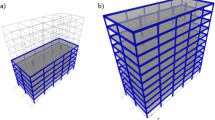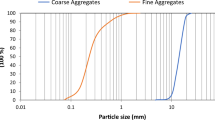Abstract
As a developing nation, Pakistan faces financial obstacles in road construction, which is essential for economic growth but costly. A sustainable approach to address environmental concerns involves using recycled materials in road construction. The construction industry has largely overlooked recycling despite the significant amount of debris generated during construction and demolition. Repurposing materials from building and demolition activities, such as rubber from tires and drywall waste, can serve as viable materials for subbase layers in roads. These recycled materials can improve road quality and performance while mitigating environmental and health risks associated with stockpiling and disposal. This research evaluates the physical and mechanical properties of recycled concrete aggregates (RCA) combined with drywall waste (DW), waste tire rubber (WTR), and quarry dust (QD) for flexible pavement subbases. The study investigated the effect of adding 0.5%, 1%, 1.5%, and 2% crumb rubber with 5%, 10%, 15%, and 20% DW as a percentage of fine aggregate with QD in RCA. By subjecting RCA to a series of tests, their strength, durability, and stability are thoroughly assessed to determine the optimal ratios of WCR and DW. As a result of these evaluations, a notable improvement in compressive strength is observed. Cost analysis demonstrates the economic feasibility of using recycled materials in pavement subbase construction, offering a cost-effective, sustainable, and environmentally safe solution that reduces reliance on fresh aggregates (FA).















Similar content being viewed by others
Abbreviations
- AASHTO:
-
American association of state highway and transportation officials
- ASTM:
-
American society for testing and materials
- C&D:
-
Construction and demolition
- CBR:
-
California bearing ratio
- CBR(S) :
-
Soaked california bearing ratio
- WTR:
-
Waste tire rubber
- D50 :
-
Mean grain size
- DW:
-
Drywall
- FA:
-
Fresh aggregates
- MDD:
-
Maximum dry density
- MR :
-
Resilient modulus
- MR(SB) :
-
Resilient modulus of subbase layer
- NHA:
-
National highway authority
- OMC:
-
Optimum moisture content
- PCSIR:
-
Pakistan council of scientific and industrial research
- RCA:
-
Recycled concrete aggregates
References
Fatta D, Papadopoulos A, Avramikos E, Sgourou E, Moustakas K, Kourmoussis F, Mentzis A, Loizidou M (2003) Generation and management of construction and demolition waste in Greece—an existing challenge. Resour Conserv Recycl 40(1):81–91. https://doi.org/10.1016/S0921-3449(03)00035-1
Mujtaba H, Khalid U, Ur Rehman Z, Farooq K (2022) Recycling of reclaimed subbase materials in flexible pavement design. Road Mater Pavement Des 23(12):2713–2732. https://doi.org/10.1080/14680629.2021.1995470
Matson PA, McDowell WH, Townsend AR, Vitousek PM (1999) The globalization of N deposition: ecosystem consequences in tropical environments. Biogeochemistry 46(1–3):67–83. https://doi.org/10.1007/BF01007574
Puskás A, Corbu O, Szilágyi H, Moga LM (2014) Construction waste disposal practices: the recycling and recovery of waste. WIT Trans Ecol Environ 191:1313–1321. https://doi.org/10.2495/SC141102
Martinho FCG, Picado-Santos LGC, SD. (2018) Feasibility assessment of the use of recycled aggregates for asphalt mixtures. Sustainability. https://doi.org/10.3390/su10061737
Wilson DC, Rodic L, Modak P, Soos R, Rogero AC, Velis C, ve Simonett, O, (2015) Global waste management outlook (GWMO). Osaka, Japan, UNEP DTIE International Environmental Technology Centre
Mehrabian P (2020) The effect of electronic quality of municipal services on customer satisfaction and loyalty according to the mediating role of perceived value by customers and customer trust in the deputy of finance and urban economics of Tehran municipality. Urban Econ Plan 1(1):53–60
Busari A, Adeyanju E, Loto T, Ademola D (2019) Recycled aggregate in pavement construction: review of literatures. J Phys Conf Ser. https://doi.org/10.1088/1742-6596/1378/2/022026
Chen MA, Lin JT, Wu SP, Liu CH (2011) Utilization of recycled brick powder as alternative filler in asphalt mixture. Constr Build Mater 25(4):1532–1536. https://doi.org/10.1016/j.conbuildmat.2010.08.005
Puthussery JV, Kumar R, Garg A (2017) Evaluation of recycled concrete aggregates for their suitability in construction activities: an experimental study. Waste Manag 60:270–276. https://doi.org/10.1016/j.wasman.2016.06.008
Li Q, Hu J (2020) Mechanical and durability properties of cement-stabilized recycled concrete aggregate. Sustaintainability. https://doi.org/10.3390/SU12187380
Arulrajah A, Piratheepan J, Disfani MM, Bo MW (2013) Resilient moduli response of recycled construction and demolition materials in pavement subbase applications. J Mater Civ Eng 25(12):1920–1928. https://doi.org/10.1061/(asce)mt.1943-5533.0000766
Behera M, Bhattacharyya SK, Minocha AK, Deoliya R, Maiti S (2014) Recycled aggregate from C&D waste & its use in concrete - a breakthrough towards sustainability in construction sector: a review. Constr Build Mater 68:501–516. https://doi.org/10.1016/j.conbuildmat.2014.07.003
Bocci E, Cerni G, Colagrande S (2016) Mechanical behaviour of asphalt concrete containing C&D recycled materials. RILEM Bookseries 11:557–568. https://doi.org/10.1007/978-94-017-7342-3_45
John NJ, Khan I, Patel A (2023) Evaluation of the crushing characteristics of industrial waste aggregates as construction materials. Constr Build Mater. https://doi.org/10.1016/j.conbuildmat.2023.133111
John NJ, Khan I, Kandalai S, Patel A (2023) Particle breakage in construction materials: a geotechnical perspective. Constr Build Mater. https://doi.org/10.1016/j.conbuildmat.2023.131308
Shah SKH, Uchimura T, Kawamoto K (2022) Permanent deformation and breakage response of recycled concrete aggregates under cyclic loading subject to moisture change. Sustainability 14(9):2022. https://doi.org/10.3390/su14095427
Shah SKH, Kayani JQ, Uchimura T, Kawamoto K (2021) Effect of degree of saturation on particle breakage of recycled concrete aggregate under cyclic loading. Int J GEOMATE 81(20):72–78
Shah, SKH, Kayani, JQ, Uchimura, T, Kawamoto, K (2021) Effect of degree of saturation on particle breakage of recycled concrete aggregate under cyclic loading. 6th Int. Conf. on Structure, Engineering and Environment (SEE), Kyoto, Japan
Shah SKH, Uchimura T, Kawamoto K (2021) Effect of moisture content on particle breakage of recycled concrete aggregates during compaction. Advances in sustainable construction and resource management. Lecture Notes Civil Eng. https://doi.org/10.1007/978-981-16-0077-7_4
Beja IA, Motta R, Bernucci LB (2020) Application of recycled aggregates from construction and demolition waste with portland cement and hydrated lime as pavement subbase in Brazil. Constr Build Mater. https://doi.org/10.1016/j.conbuildmat.2020.119520
Kushwaha SS, Kishan D (2016) Stabilization of red mud by lime and gypsum and investigating its possible use in geoenvironmental engineering. Geo-Chicago. https://doi.org/10.1061/9780784480144.097
Mohajerani A, Burnett L, Smith JV, Markovski S, Rodwell G, Rahman MT, Kurmus H, Mirzababaei M, Arulrajah A, Horpibulsuk S, Maghool F (2020) Recycling waste rubber tyres in construction materials and associated environmental considerations: a review. Resour Consers Recyc. https://doi.org/10.1016/j.resconrec.2020.104679
Guerra BC, Leite F, Faust KM (2020) 4D-BIM to enhance construction waste reuse and recycle planning: case studies on concrete and drywall waste streams. Waste Manag 116:79–90. https://doi.org/10.1016/j.wasman.2020.07.035
Ifeanyi N, Yuan Q (2016) Drywall (Gyproc Plasterboard) recycling and reuse as a compost–bulking agent in Canada and North America: a review. Recycling 1(3):311–320. https://doi.org/10.3390/recycling1030311
National Highway Authority (1998) General specifications. Ministry of Communications, Government of Pakistan. 565
AASHTO (1993) Guide for design of pavement structures. Washington D.C. 157
Arulrajah A, Piratheepan J, Ali MMY, Bo MW (2012) "Geotechnical properties of recycled concrete aggregate in pavement sub-base applications. ASTM Geotech Test J 35(5):743–751. https://doi.org/10.1520/GTJ103402
Kowalska M (2016) Compactness of scrap tire rubber aggregates in standard proctor test. Procedia Engineering 161:975–979. https://doi.org/10.1016/j.proeng.2016.08.836
Zhang J, Kim H, Dubey B, Townsend T (2017) Arsenic leaching and speciation in C&D debris landfills and the relationship with gypsum drywall content. Waste Manage 59:324–329. https://doi.org/10.1016/j.wasman.2016.10.023
Jang YC, Townsend T (2001) Sulfate leaching from recovered construction and demolition debris fines. Adv Environ Res 5(3):203–217. https://doi.org/10.1016/S1093-0191(00)00056-3
Bumanis G, Zorica J, Korjakins A, Bajare D (2022) Processing of gypsum construction and demolition waste and properties of secondary gypsum binder. Recycling. https://doi.org/10.3390/recycling7030030
Ajay C, Rani KD (2023) Evaluation of cement-treated ferrochrome slag and quarry dust composites for base and sub-base layers of flexible pavement. Res Eng Struct Mater. https://doi.org/10.17515/resm2023.559.ma1010
Dixit MS, Patil KA (2016) Utilization of stone dust to improve the properties of expansive soil. Int J Civil Eng Tech 7(4):440–447
AASHTO-T27 Sieve analysis of fine and coarse aggregate. Washington D.C.
McNeil K, Kang THK (2013) Recycled concrete aggregates: a review. Int J Concr Struct Mater 7(1):61–69. https://doi.org/10.1007/s40069-013-0032-5
Chakradhara RM, Bhattacharyya SK, Barai SV (2011) Influence of field recycled coarse aggregate on properties of concrete. Mater Struct 44:205–220. https://doi.org/10.1617/s11527-010-9620-x
Ahmed A, Ugai K, Kamei T (2010) Investigation of recycled gypsum in conjunction with waste plastic trays for ground improvement. Constr Build Mater 25(1):208–217. https://doi.org/10.1016/j.conbuildmat.2010.06.036
Amena S (2021) Experimental study on the effect of plastic waste strips and waste brick powder on strength parameters of expansive soils. Heliyon. https://doi.org/10.1016/j.heliyon.2021.e08278
Saberian M, Li J, Boroujeni M, Law D, Li CQ (2019) Application of demolition wastes mixed with crushed glass and crumb rubber in pavement base/subbase. Resour Conserv Recycl. https://doi.org/10.1016/j.resconrec.2020.104722
Acknowledgements
Authors are grateful to the National Institute of Transportation at National University of Sciences and Technology (NUST), Pakistan for their technical assistance and excellent laboratory space.
Author information
Authors and Affiliations
Corresponding author
Additional information
Publisher's Note
Springer Nature remains neutral with regard to jurisdictional claims in published maps and institutional affiliations.
Rights and permissions
Springer Nature or its licensor (e.g. a society or other partner) holds exclusive rights to this article under a publishing agreement with the author(s) or other rightsholder(s); author self-archiving of the accepted manuscript version of this article is solely governed by the terms of such publishing agreement and applicable law.
About this article
Cite this article
Ahmed, A., Shah, S.K.H., Ahmad, N. et al. Feasibility of utilizing recycled concrete aggregate blended with waste tire rubber and drywall waste as pavement subbase material. J Mater Cycles Waste Manag (2024). https://doi.org/10.1007/s10163-024-01967-x
Received:
Accepted:
Published:
DOI: https://doi.org/10.1007/s10163-024-01967-x




